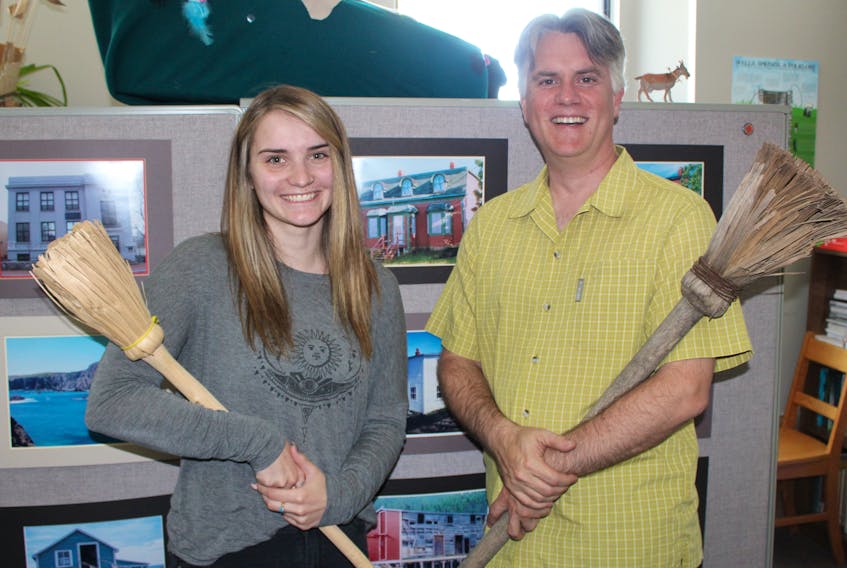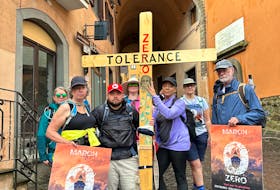ST. JOHN'S, N.L. — Tea dolls, mill baskets, komatiks … no more?
But what is a tea doll or mill basket? The little voice in your head may be itching to know.
They are heritage crafts in the province, and those questions are what has brought Dale Jarvis and Rachel Green together to investigate whether these and other crafts are in danger of disappearing.
Jarvis, intangible cultural heritage development officer for Heritage NL, and Green, craft researcher for the Craft Council of NL and Heritage NL, have started a survey called, “NL Heritage Crafts at Risk.”
“A generation of people have found a different type of work or have moved away. You don’t necessarily have that flow of information across the generations.” — Dale Jarvis
The survey is being used to create a list of heritage crafts still being carried out by people in the province. Jarvis and Green hope to use the list to create a buzz, connect crafters and ensure the skills are available for future generations to learn.
The crafters of Newfoundland and Labrador have a chance to go down in the history books, essentially.
“I suspect there are all kinds of things that we used to make here that we don’t even consider making anymore. We just go and buy everything,” Jarvis said. “A generation of people have found a different type of work or have moved away. You don’t necessarily have that flow of information across the generations.”
So, if there is anyone out there still making birch brooms, hand-making bricks, or even coopering away in your spare time — you are who Jarvis and Green want to speak with.
“Maybe looking backwards is a really modern way of doing things now,” Jarvis said.
Mill basket
A mill basket was oval-shaped and resembled a picnic basket, with handles and a lid fitted to the top.
They were usually handmade from different sorts of wood.
Angus Gunn, a popular maker of mill baskets from Grand Falls-Windsor, would make his out of broken hockey sticks, soaked to make them pliable.

It was small enough to carry comfortably in your arms, and large enough to carry hot meals.
Mill workers would take their lunches to work in these baskets.
Andy Barker is a school librarian who grew up in Grand Falls-Windsor when the paper mill was still operating.
His non-fiction prose “Lunch Baskets” won the senior division for non-fictional prose in 2010 in the provincial arts and letters competition.
Barker described mill baskets as a source of pride for workers in paper mills and a toy at times for children.
“It was always, to me, a symbol of a job,” Barker said.
The men who carried mill baskets did so with a certain style, he said.
Barker remembers digging through his father’s basket when the workday finished, searching for a leftover snack, and then using the basket for play time.
On his walks to and from the mill, he saw certain men who were known as “lunch basket carriers.”
These were men who were considered mentally challenged and whom some workers got to carry their baskets for them.
“There was one man I remember who would carry three lunch baskets, one on each arm and one in the middle,” Barker said.
Pranks were in no shortage at the mill.
Barker recalls a man who had his chocolate cake stolen and sought revenge by nailing the thief’s mill basket to a bench.
“This particular man would always leave the mill in a hurry. He would just grab his lunch basket from the handles running full force out of the mill,” Barker said.
“When he ran by, he literally just grabbed the handles, because the rest of the basket was still there bolted down.”
Ultimately, the mill baskets meant there was work. The crafters who made them, the men and children who carried them, and the women who packed them, did so with pride.
Mill baskets are no longer a tradition in Newfoundland, and Barker says the loss of such items represents a loss of history.
“It was a loss of trades, skills, and a loss of knowledge,” he said.
Tea dolls
Tea dolls were a way of survival and teaching for Indigenous people.
A tea doll is a stitched doll made to resemble a person wearing traditional Innu clothing, everything from the colours on their hats, down to the undergarments.

Animal hides, commonly caribou, were used for the face and other parts of the dolls.
Mothers made the dolls for their children to help them learn responsibility.
The doll would be stuffed with tea leaves and children would be tasked with carrying their dolls, and the family’s tea leaves, from campsite to campsite.
A majority of the tea dolls found in Newfoundland and Labrador can be traced back to Angela Andrew.
Andrew was a Labrador artist and was thought to be one of the last people making Tea Dolls.
She died in February, and since then others have followed in her footsteps.
Victoria Elson is Andrew’s granddaughter and she doesn’t believe the tradition has been lost in her hometown of Sheshatshiu.
“I may be biased, but I think my grandmother was the first one to bring (tea doll making) back and start it again around the community,” Elson said. “As Sheshatshiu got settled into a community, she was seeing a lot of decline in tradition, and as she grew older she wanted to bring some of that back.”
Elson said young people in Sheshatshiu know more about it now because of a focus on Innu culture in the education system.
“I wouldn’t say there is a decline now,” Elson said. “It was (a decline that) my grandmother saw in the ‘60s, ‘70s and ‘80s. That’s why she began bringing back that particular tradition.
“They are more for collecting now,” she said. “I think it would be a terrible thing to lose because it’s such an important factor in my life, and if I were to lose that, it would be like losing my grandmother.”
Jarvis and Green’s survey can be found online at www.heritagecraft.ca.
Twitter: @JasmineBurtNL
RELATED









